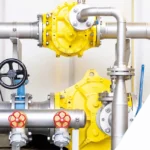
Advancements in Industrial Safety -Foam Dosing Systems
November 21, 2023
Advancements in Industrial Safety -Foam Dosing Systems
November 21, 2023Technical Library
LHD Systems in
Conveyor Applications
Linear Heat Detection Systems in Conveyor Systems
Introduction:
Linear heat detection systems (LHDS) have emerged as indispensable tools in fire detection and protection, especially in complex industrial environments. This expert-level technical article explores the intricacies of applying linear heat detection systems to conveyor systems, shedding light on the principles, design considerations, and advantages that make LHDS a critical component in safeguarding these vital industrial processes.
Understanding Linear Heat Detection Systems:
1-Principles of Operation:
-
- Linear heat detection systems operate on the principle of detecting changes in temperature along a sensing cable or wire.
- The sensing element, typically made of advanced polymers or alloys, is sensitive to temperature variations and triggers an alarm when predetermined thresholds are exceeded.
2-Types of Sensing Cables:
-
- LHDS commonly employs two types of sensing cables: fixed-temperature and rate-of-rise.
- Fixed-temperature cables trigger an alarm when the temperature at any point along the cable exceeds a set threshold, while rate-of-rise cables detect rapid temperature increases.
Application in Conveyor Systems:
1-Early Detection in Challenging Environments:
-
- Conveyor systems, prevalent in industries like manufacturing, mining, and logistics, present unique challenges for fire detection.
- LHDS provides early detection by continuously monitoring the entire length of the conveyor system, swiftly identifying temperature anomalies indicative of potential fires.
2-Variable Sensitivity Profiles:
-
- The design of LHDS allows for the customization of sensitivity profiles along the sensing cable.
- Conveyor systems often have different risk zones, and LHDS can be tailored to provide higher sensitivity in areas where the fire risk is elevated.
3-Integration with Control Systems:
-
- LHDS seamlessly integrates with conveyor control systems, allowing for immediate shutdown in the event of a detected fire.
- Integration ensures a swift response to prevent the spread of fire and damage to valuable assets.
Design Considerations for Conveyor Applications:
1-Sensing Cable Placement:
-
- Proper placement of the sensing cable is critical in conveyor systems.
- Considering factors such as material flow, temperature differentials, and potential fire sources, designers strategically position the sensing cable to maximize coverage.
2-Environmental Factors:
-
- Conveyor systems often operate in challenging environments, including exposure to dust, vibrations, and varying temperatures.
- LHDS components must be robust and resilient to withstand these conditions without compromising performance.
3-False Alarm Mitigation:
-
- Conveyor systems may generate transient temperature increases during normal operations.
- Advanced algorithms and signal processing techniques are employed to distinguish between normal variations and actual fire events, minimizing false alarms.
Advantages of Linear Heat Detection Systems in Conveyor Applications:
1-Continuous Monitoring:
-
- LHDS provides continuous monitoring along the entire length of the conveyor system, ensuring that potential fire events are detected promptly.
2-Flexibility in Design:
-
- The flexibility of LHDS allows for customized designs, accommodating the specific layout and characteristics of different conveyor systems.
3-Predictive Maintenance:
-
- Beyond fire detection, LHDS can contribute to predictive maintenance by identifying areas with abnormal temperature patterns, indicating potential mechanical issues in the conveyor system.
4-Reliability in Harsh Environments:
-
- LHDS components are designed to withstand harsh industrial environments, making them reliable and durable in challenging conditions.
Conclusion:
Linear heat detection systems play a crucial role in enhancing fire safety measures in conveyor systems. The ability to provide early detection, customization in sensitivity profiles, and seamless integration with control systems make LHDS a sophisticated and effective solution for safeguarding critical industrial processes. As industries continue to prioritize safety and automation, the utilization of advanced technologies like LHDS in conveyor applications is expected to evolve, further optimizing the protection of assets and ensuring the uninterrupted operation of conveyor systems in diverse industrial settings.
